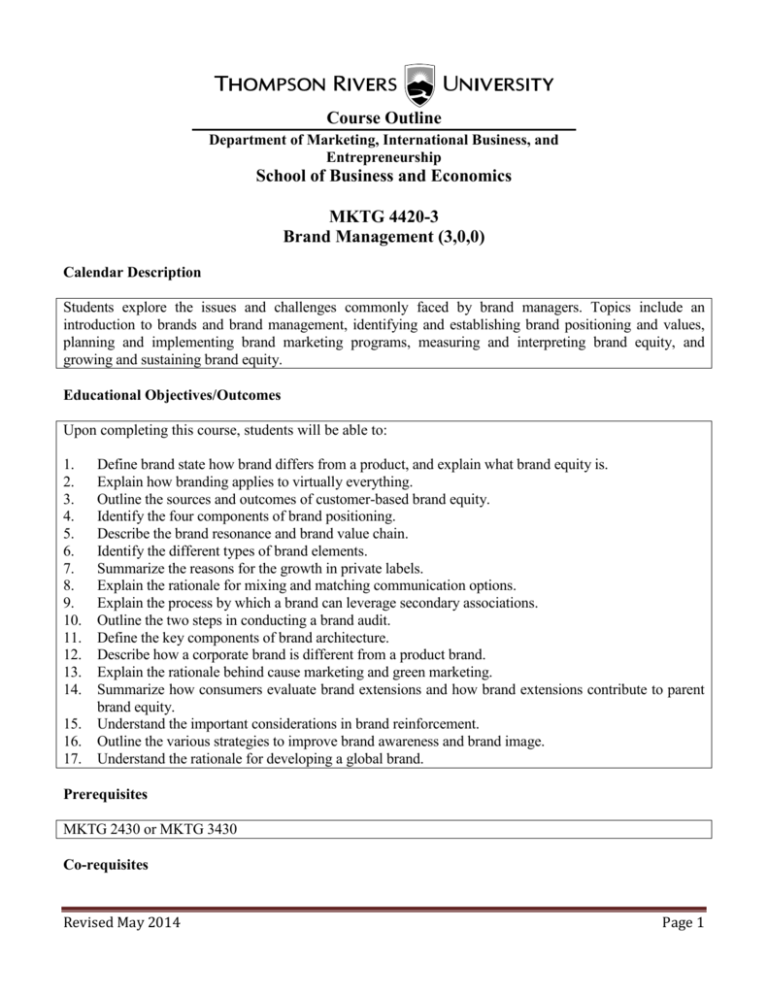
Course Outline
Department of Marketing, International Business, and
Entrepreneurship
School of Business and Economics
MKTG 4420-3
Brand Management (3,0,0)
Calendar Description
Students explore the issues and challenges commonly faced by brand managers. Topics include an
introduction to brands and brand management, identifying and establishing brand positioning and values,
planning and implementing brand marketing programs, measuring and interpreting brand equity, and
growing and sustaining brand equity.
Educational Objectives/Outcomes
Upon completing this course, students will be able to:
1.
2.
3.
4.
5.
6.
7.
8.
9.
10.
11.
12.
13.
14.
15.
16.
17.
Define brand state how brand differs from a product, and explain what brand equity is.
Explain how branding applies to virtually everything.
Outline the sources and outcomes of customer-based brand equity.
Identify the four components of brand positioning.
Describe the brand resonance and brand value chain.
Identify the different types of brand elements.
Summarize the reasons for the growth in private labels.
Explain the rationale for mixing and matching communication options.
Explain the process by which a brand can leverage secondary associations.
Outline the two steps in conducting a brand audit.
Define the key components of brand architecture.
Describe how a corporate brand is different from a product brand.
Explain the rationale behind cause marketing and green marketing.
Summarize how consumers evaluate brand extensions and how brand extensions contribute to parent
brand equity.
Understand the important considerations in brand reinforcement.
Outline the various strategies to improve brand awareness and brand image.
Understand the rationale for developing a global brand.
Prerequisites
MKTG 2430 or MKTG 3430
Co-requisites
Revised May 2014
Page 1
None
Texts/Materials
Kevin Lane Keller, Strategic Brand Management: Building, Measuring, and Managing Brand Equity,
Pearson Prentice Hall.
Student Evaluation
Term tests
Quizzes
Participation/attendance
Case studies/research projects/assignments
Major project/brand audit
Final exam
20-50%
0-10%
0-10%
20-40%
20-40%
25-40%
Midterm and final exams must not make up more than 70% of evaluation and group work must not make
up more than 50%.
Course Topics
1. Introduction to Brands and Brand Management
What is a brand?
Why do brands matter?
Branding challenges and opportunities
The brand equity concept
Strategic brand management process
2. Identifying and Establishing Brand Positioning and Values
Customer-based brand equity and brand positioning
Sources of brand equity
Identifying & establishing brand positioning
Defining a brand mantra
Brand resonance and the brand value chain
Building a strong brand: The four steps of brand building
The brand value chain
3. Planning and Implementing Brand Marketing Programs
Choosing brand elements to build brand equity
Criteria for choosing brand elements
Options and tactics for brand elements
Designing marketing programs to build brand equity
New prospective on marketing
Integrating marketing
Product strategy
Revised May 2014
Page 2
Pricing strategy
Channel strategy
Integrating marketing communications to build brand equity
The new media environment
Four major marketing communication options
Brand amplifiers
Developing IMC programs
Leveraging secondary brand associations to build brand equity
Conceptualizing the leveraging process
Country of origin and other geographic areas
Channels of distribution
Co-Branding
Licensing
Celebrity endorsement
Sporting, cultural, or other events
Third-party sources
4. Measuring and Interpreting Brand Performance
Developing a brand equity measurement and management system
Conducting brand audits
Establishing a brand equity management system
Maximizing internal branding
5. Growing and Sustaining Brand Equity
Introducing and naming new products and brand extensions
Advantages and disadvantages of extensions
Understanding how consumers evaluate brand extensions
Evaluating brand extension opportunities
Managing brands over time
Reinforcing brands
Revitalizing brands
Adjustments to the brand portfolio
Managing brands over geographic boundaries and market segments
Regional market segments
Other demographic and cultural segments
Rationale for going international
Advantages of global marketing programs
Disadvantages of global marketing programs
Global brand strategy
Standardization versus customization
Developing versus developed markets
Building global customer-based brand equity
Methods for Prior Learning Assessment and Recognition
As per TRU policy
Revised May 2014
Page 3
Attendance Requirements – Include if different from TRU Policy
As per TRU policy
Revised May 2014
Page 4







